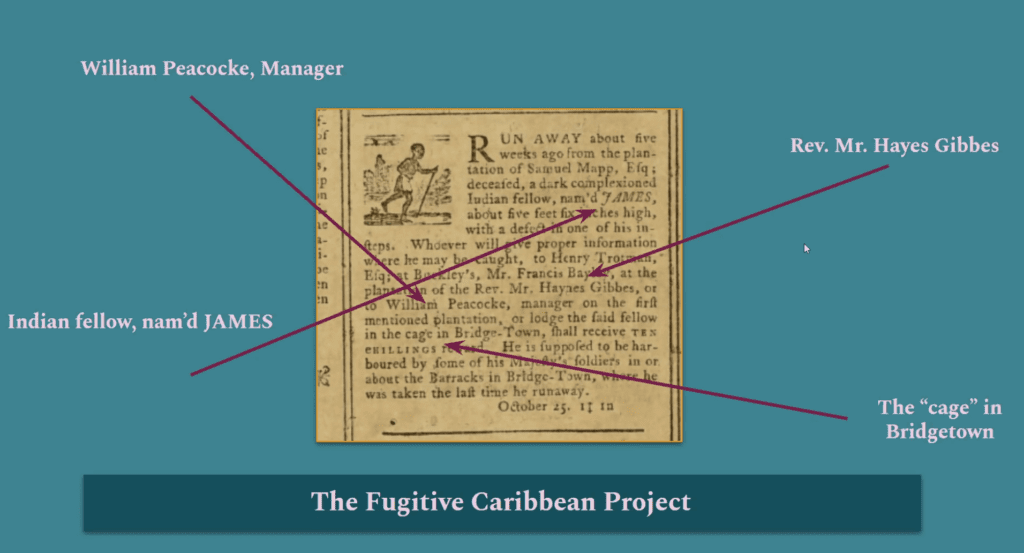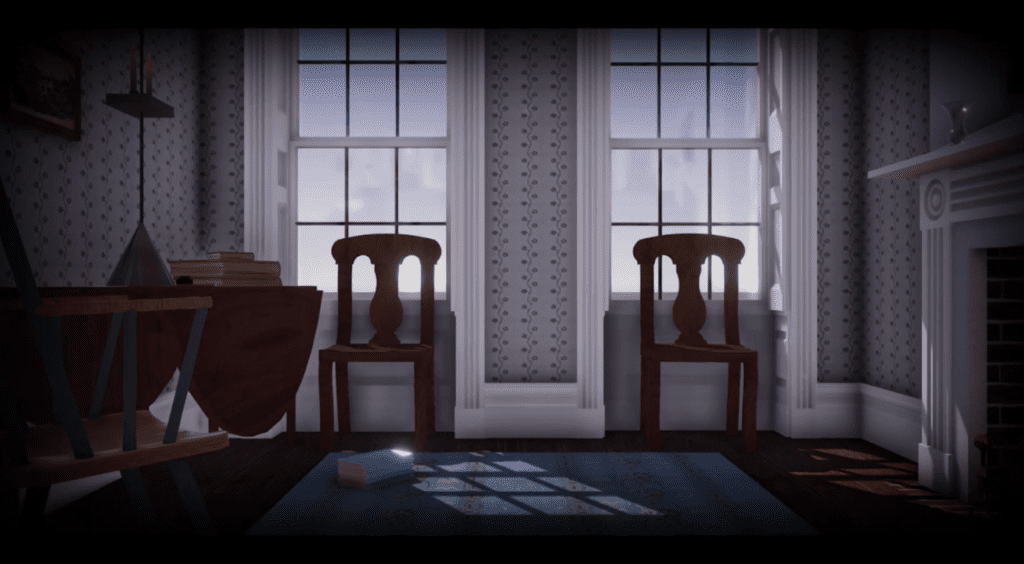On Oct 27, 2021, at a special session of DH Open Office Hours, recipients of NULab Seedling and Travel Grants shared their exciting projects in a round of lightning talks. Weekly DH Open Office Hours are organized by the Digital Scholarship Group and the NULab for Texts, Maps, and Networks. The panelists were Avery Blankenship, a Ph.D. student in the English Department; Jacob Murel, a Ph.D. candidate also in the English Department; and the team of Jessica C. Linker, assistant professor of History and Ángel David Nieves professor of Africana Studies, History, Digital Humanities, and English. NULab Assistant Director Sarah Connell moderated the event.
Avery Blankenship began the lightning talks with her presentation on the “Speculation in the Archive: The Fugitive Caribbean Project and Speculative Knowledge.” This project is part of the Early Caribbean Digital Archive (ECDA), an open-access collection of pre-twentieth-century Caribbean texts, maps, and images. ECDA’s The Fugitive Caribbean project started with the digitization of the Barbados Mercury, and the Bridge-town Gazette (1762–1848), a historical newspaper from Bridgetown, Barbados, in 2019. The project emphasizes the study of fugitive slave ads in the newspaper and ways to open them up for remixing and decolonizing. Blankenship explained that though the ads were very short, they provided a lot of information on somebody who otherwise might not be reflected in archival documents. The ads act almost like embedded slave narratives and open up the possibility of thinking about critically informed practices of speculation, creating a desire to fill in the gaps that are in these micro-narratives. Therefore, the goal of The Fugitive Caribbean project was defined as facilitating encounters with the archives of transatlantic slavery, which draw upon critically engaged practices of speculation.
This project identified and clipped roughly 752 ads in the newspaper, and then put them on a Zooniverse platform that allows for crowdsourced transcription. Blankenship noted that the decision to use Zooinverse was not just to expedite the process of transcribing, but to also invite users to contribute in really meaningful ways to the project and to encourage thinking about the process of transcription as a form of labor that often is made invisible in a lot of archival work. Users transcribed the ads and answered metadata questions. Metadata, especially on geographical information from the ads, was later used to map a set of speculated pathways that might have been taken by the persons in the ads. Blankenship concluded her presentation by emphasizing that the Seedling Grant is helping ECDA expand ways to take this project into classroom spaces and facilitate the acts of critically engaged speculation. For example, they are encouraging students to think of encoding and digital editing as processes of interpretation, conduct rhetorical analysis to analyze the word usage in the ads, and tease out additional geographic information and speculative pathways.

Jacob Murel discussed his research on the Early Modern Anatomy Theaters and Dissections, which has the objective to perceive how people in early modern England understood dissection. Murel used word embedding models to analyze language surrounding ‘anatomy’ and ‘dissection’ in two different textual corpora: early modern drama and early modern medical texts. He claimed that in the past scholars have often compared the playhouse and the anatomy theater as sites of theatrical bodily performance. However, Murel questions this overt comparison and believes that there might be subtle differences if one studies not just the language that is used, but how that language is used. Therefore, Murel used word embedding models as a way to reapproach the texts. He worked with English Printed Drama from the early 16th century to the end of the 17th century and the Early Modern English Medical Texts collection. Together the corpora contains about 2 million words.
Murel shared that he ran multiple models on the two corpora to figure out what sort of parameters would be best to produce consistent results. However, no two models generated the same results hence this process turned out to be more exploratory rather than definitive. Nevertheless, the process was helpful in generating a list of terms that were recorded throughout each of the models. Murel was then able to analyze words that appear closest to the word ‘anatomy’ or ‘dissection’ in the vector space, wherein words that are close in vector space are likely to be used in the same contexts throughout the corpus. Murel found that, in the drama texts, the words that frequently appeared most often in the models close to the word ‘anatomy’ were words like onion or anagram or tomb. Searching through the text he found that a lot of these terms were used in ways that talked about rearranging parts, taking things apart, or opening them up to reveal some essential nature. In contrast, medical texts were far less consistent and there were very few terms that appeared in every model. Moreover, medical texts often spoke of ‘anatomy’ as an event or a textual object like a chapter or catalogue or lecture. Interestingly the word ‘anatomy’ was almost never used in relation to the actual body within this corpus.
Ángel David Nieves and Jessica Linker spoke about the first phase of the 3D Black Boston Project, a multi-year collaboration between faculty, students, and cultural heritage institutions. The project uses immersive 3D technologies to create virtual reality experiences of nineteenth-century Black heritage sites in Boston. The project supports students to learn how to conduct research and understand the mechanics of building a virtual reality simulation. Currently, the team is working on spaces related to David Walker, the radical Black abolitionist, and author of Walker’s Appeal (1829). Linker and Nieves want users/visitors to interact with the 3D models of key objects to think about traditions of intellectual life, the experiences of young black families and early Boston, Black business practices, and most importantly, activist traditions. They believe that this project will have resonance in the museum community broadly because virtual reality offers the opportunity to allow historical interpretation for sites that no longer exist or where access may pose complicated issues. For example, the location of Walker’s residents has been extensively renovated.

For this project, Nieves and Linker assembled a team of five undergraduate students and one graduate student. The purpose of hiring students was to provide learning spaces and opportunities outside of the classroom and curriculum. The focus was on mentoring the team as they learned remote archival research, the creation of 3D models, and the use of the Unity 3D Engine. Students were provided the opportunity to share scholarly credits including blog space on the 3D Black Boston website, and presentations at conferences. Both Linker and Nieves shared that though they have trained student cohorts in this kind of work in the past, things were very different in a pandemic scenario. They faced many challenges but also saw some positive outcomes. For example, students could not visit the archives and were taught to look for digital sources instead. They couldn’t really handle material objects but were taught how to think about them and how to curate stories through an assemblage of key items. This project also generated camaraderie during some very challenging and isolating times.
A question-and-answer session followed the presentations. Avery Blanckenship explained that the Zooniverse platform is easy to use, and is designed to reduce errors through options like a restrictive set of questions in the metadata categories and systems for cross-checking multiple transcriptions. She also shared that all the metadata answers can be downloaded in .csv format where each question has its own column, which is helpful for data management and analysis. Nieves and Linker responded to a question regarding the robustness or lack thereof of sources for doing the 3D reproductions. They explained that a set of different sources helped them make decisions about the architecture and the objects in the room (at 8 Belknap Street). For example: mining the text records, architectural archaeological surveys, physical aspects/dimensions of the plot, external visible architectural elements, inventory of the items in the house, and visits/experiences of similar houses. One of the final questions was about the integration of pedagogy in the digital humanities projects. Both Linker and Blankenship placed importance on integrating pedagogy with the projects early on, hiring students who lack the knowledge or expertise, and training them as a core component of their projects. Nieves also mentioned that it is important to be especially flexible when working with undergraduates, because they are often looking for mentors that will help them model both ways of being in the world as professionals and ways to bridge their academic pursuits with their personal, political, and social justice minded selves.
NULab seedling and travel grants are open to Northeastern University faculty and graduate students. During the COVID-19 pandemic, travel grants can be used to cover expenses related to online events. More information about NULab grants can be found on the “Seedling and Travel Grants” page.







